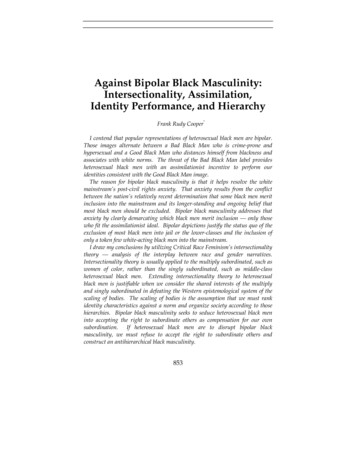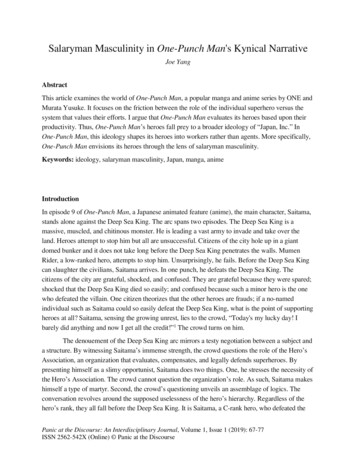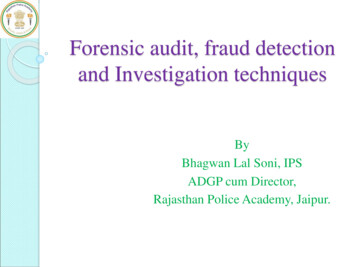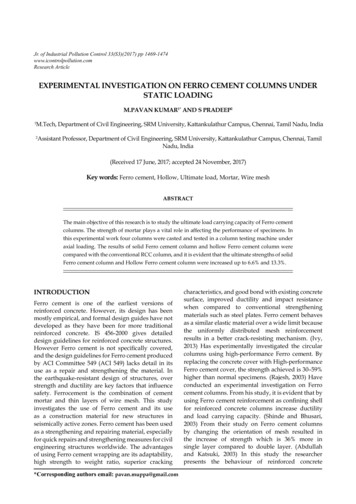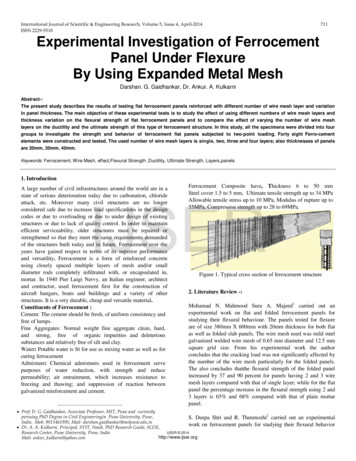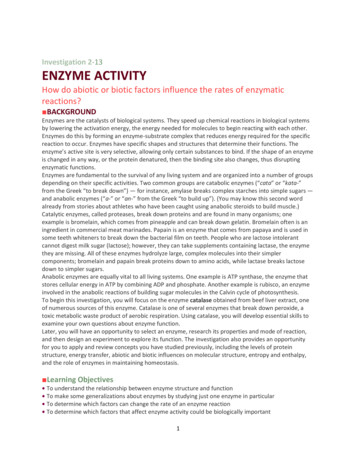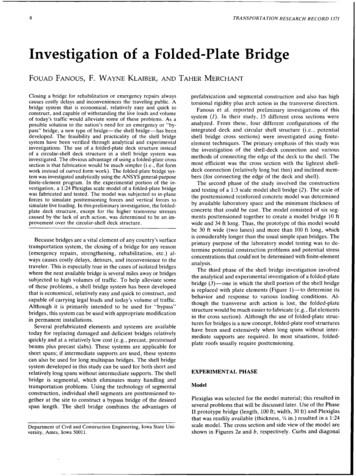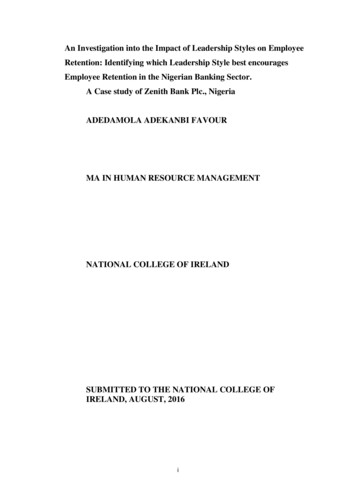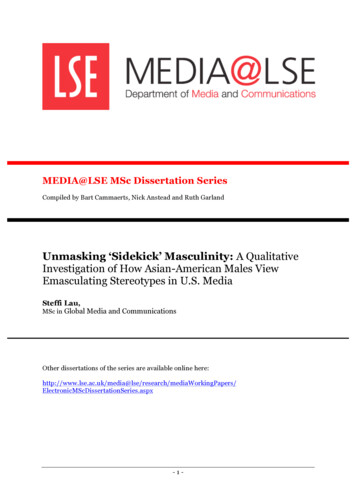
Transcription
MEDIA@LSE MSc Dissertation SeriesCompiled by Bart Cammaerts, Nick Anstead and Ruth GarlandUnmasking ‘Sidekick’ Masculinity: A QualitativeInvestigation of How Asian-American Males ViewEmasculating Stereotypes in U.S. MediaSteffi Lau,MSc in Global Media and CommunicationsOther dissertations of the series are available online -1-
Dissertation submitted to the Department of Media and Communications,London School of Economics and Political Science, August 2015, in partialfulfilment of the requirements for the MSc in Media, Communication andDevelopment. Supervised by Dr. Shakuntala Banaji.The Author can be contacted at: steffitracy@gmail.comPublished by Media@LSE, London School of Economics and Political Science (‘LSE’),Houghton Street, London WC2A 2AE. The LSE is a School of the University of London. It isa Charity and is incorporated in England as a company limited by guarantee under theCompanies Act (Reg number 70527).Copyright, Steffi Lau 2015.The authors have asserted their moral rights.All rights reserved. No part of this publication may be reproduced, stored in a retrievalsystem or transmitted in any form or by any means without the prior permission in writing ofthe publisher nor be issued to the public or circulated in any form of binding or cover otherthan that in which it is published. In the interests of providing a free flow of debate, viewsexpressed in this dissertation are not necessarily those of the compilers or the LSE.-2-
MSc Dissertation of Steffi LauUnmasking ‘Sidekick’ Masculinity: A QualitativeInvestigation of How Asian-American Males ViewEmasculating Stereotypes in U.S. MediaSteffi LauABSTRACTThis paper sought to explore how Asian-American males perceive stereotypical mediaportrayals of themselves in relation to their identity and masculinity and conversely, howthey construct identity and masculinity in relation to emasculating media representations.Through semi-structured interviews, this research explored the inner worlds and lifenarratives of 23 Asian-American men. Using thematic analysis, I found that Asian-Americanmen by and large negatively view and reject media’s emasculating images of themselves andfind resistance in choosing to assert their masculinity and identity in other ways.Nonetheless, as identity is not produced in a vacuum, but is socially recognized, AsianAmerican men suffer from being ascribed unwanted identities out of their control.INTRODUCTIONI am an Oriental. And being an Oriental, I could never be completely a man. – M. ButterflyIn February 2012, after singlehandedly converting a dismal game into victory for the NewYork Knicks, a virtually unknown basketball player, Jeremy Lin, burst into the globalspotlight, as he drove ‘near-superhuman’ point leads that led his team to victory over anunparalleled winning streak spanning seven games and toppling historical statistics(Freeman, 2012). Yet what made this underdog’s rise to stardom even more remarkable washis background: the athletic, charismatic 6’3’ Taiwanese-American was an unprecedentedrarity in the league, defying stereotypes of Asian-American men as bookish, puny andphysically inept.But even in the whirlwind of popularity dubbed ‘Linsanity,’ disturbing racial undertonesemerged: The New York Post printed a controversial headline that read ‘Chink in the Armor.’Equally offensively, a Fox Sports columnist tweeted, ‘Some lucky lady in NYC is gonna feel a-1-
MSc Dissertation of Steffi Laucouple inches of pain tonight’ (Freeman, 2012).Not only did this demeaning statement allude to an oft-repeated stereotype of Asian menhaving small penises, it played into a trend cemented in American media over the pastcentury: the painting of Asian-American men as alternatively lustful outcasts with ‘weaksexual abilities’ (Wong et al. 2012: 1) or emasculated, diminutive ‘men’ defined by a ‘strikingabsence down there’ (Fung, 2008: 237) Altogether, these racially charged media gaffeshighlighted a more unsettling problem: the naturalized acceptability of racism against AsianAmerican men in media and society. As one commentator pointed out, it is unthinkable thateven a ‘half-brained TV presenter would use racial slurs against a black player equivalent tothe Asian ones that have been used against Lin’ (Freeman, 2012).These emasculating media portrayals of Asian-American men can be traced back to the mid1800s when Chinese men arrived in the U.S. en masse, fulfilling a need for cheap labour(Shek, 2006). With laws limiting the immigration of Chinese women, Chinese men largelylived in bachelor societies. Fearing intermarriage, the U.S. government passed antimiscegenation laws threatening to revoke the citizenship of white women who out-married.Reinforcing these fears was the circulation of Yellow Peril propaganda portraying Asian menas ‘sexually deviant, asexual, effeminate’ predators (Shek, 2006: 381). Furthermore, jobopportunities were limited to traditionally female work such as laundry and cooking, furtherexacerbating their effeminate image (Takaki, 1993). Essentially, early conceptions of AsianAmerican masculinity were constructed to be disempowering in relations with employers andwhite society (Chua & Fujino, 1999).As history has progressed, the racial castration of Asian-American men in the media hascontinued (Eng, 2001). The 20th century ushered in further pejorative images of AsianAmerican men in movies, including supervillain Fu Manchu (1929) who embodied a ‘lack ofheterosexuality’; Sixteen Candles (1984) which featured sex-starved exchange student LongDuk Dong accompanied by a gong chiming at his every appearance; and The Joy Luck Club(1993), a movie celebrated for its depiction of Chinese-American mother-daughterrelationships, but with ‘few, if any, redeeming’ (Shek, 2006: 381) portrayals of AsianAmerican men, who instead were depicted as chauvinistic and miserly, ultimately drivingfemale counterparts to white love interests (Chan, 1998).As evidenced by the Linsanity media coverage, this humiliating narrative around AsianAmerican men has continued into the 21st century. Through repeated portrayals on screen ofthe socially awkward nerd, passive sidekicks, and the restaurant owner with an unintelligible-2-
MSc Dissertation of Steffi Lauaccent, Asian-American males have been Othered and denied their masculinity throughrestrictive stereotypes reducing them to comedic tropes. Rarely are Asian-American menseen as attractive leading men, or depicted as romantic options. In fact, an analysis of the 100top-grossing films of 2013 found that Asian male characters were least likely to be inromantic relationships (28%) as compared to black men (68%), white men (58%) andHispanic men (57%)—a dramatic gap (Smith, Choueiti, & Pieper, 2013: 7).Thus far, academics have written about the racial castration, emasculation and ‘queering’ ofthe Asian-American male within the national imaginary (Eng, 2001; Parikh, 2002) from ahistorical and psychological lens. Yet to date, there remains insufficient literature from amedia perspective on the topic. Therefore, this paper seeks to explore how Asian-Americanmales interpret these emasculating representations and more importantly, how theyconstruct and navigate their identities and masculinities in relation to these.LITERATURE REVIEWIdentity and RepresentationMedia scholars have argued that representations are not only symbolic of deeper societalsentiments—they are reflective of society’s power relations. Stuart Hall writes, ‘Stereotypingtends to occur where there are gross inequalities of power’ (1997 a.: 258). Inextricable fromideology, representations are a form of hegemonic power. Therefore, studying stereotyping iscrucial as symbolic marginalization is likely reflective of a systematic exclusion of AsianAmerican men from society.As Hall writes, stereotyping plays a key role in maintainingsymbolic order through binding together ‘all of Us who are “normal” into one “imaginedcommunity”’ (1997 a.: 258). Through positioning Asian-American men as emasculated,American media place them in binary opposition to the accepted idea of Western masculinity,as deviants demarcating what is normal and what is not—akin to Edward Said’s (1978) theoryof Orientalism detailing how the West has produced the East as Other and inferior.Moreover, contextualizing and interrogating these portrayals is imperative, givenrepresentation’s undeniable capacity to ascribe unwanted identities. As Hall writes, identityemerges ‘in the dialogue between the meanings and definitions which are represented to usby the discourse of a culture, and our willingness (consciously or unconsciously) to step intothe subject positions constructed for us’ (1997 b.: 219). Similarly, Woodward asserts thatalthough we as subjects are able to choose our identifications, this internal agency is limited-3-
MSc Dissertation of Steffi Lauby external social constraints exerted over the subject within society. This tension renderssome identities ‘inaccessible or impossible’ (2000: 18). Thus, the fact that representation isintegral to identity construction—desired or not—is particularly disquieting when weconsider the degrading portrayals of Asian-American men. Unable to access desired identitieswithin society, Asian-American men may experience damaging impacts on their psyches asthey negotiate their identities as men recognized as less than men.MasculinityThe theory of hegemonic masculinity has become the backbone of masculinity research,following its proposal by R.W. Connell, who defined it as the configuration of gender practicethrough which patriarchy is legitimized and women are subordinated (1995: 77). Although aplurality of masculinities exists, hegemonic masculinity is considered the ‘the ideal type thatis glorified and associated with white men at the highest levels of society’ (Phua, 2007: 910).The definition of hegemonic masculinity is a racialized one that automatically entails theexclusion of any man who is not white and relegates homosexuality to marginalizedmasculinity and racial minorities to subordinated masculinity (Connell & Messerschmidt,2005). Meanwhile, men of colour ‘jockey’ to ‘enter the inner circle, often as ‘honorary’ eliteWhite men’ although their colour will never allow them full acceptance (Collins, 2004: 186).It is worth noting the distinction that, while literature regarding black masculinities withinthe West has been generated, little discussion has heeded the experiences of Asian men in theWest.Some point out that while Asian-Americans are ascribed docile, womanly traits,American narratives have ascribed threatening traits to other men of colour (violent black‘studs’ with large penises, macho Latinos, and Native-American rapists) which, while stillpejorative, nonetheless accentuate their masculinities as opposed to de-legitimating them(Kim, 2005: 137).Given this, some academics contend that Connell’s perspective is organized around agendered lens—if the hierarchy is fundamentally structured around race, one could arguethat privilege is determined by race, with gay masculinity marginalized and minoritymasculinity subordinated (Phua, 2007). Under this supposition, a gay man within the race ofpower may benefit more from existing power dynamics than a straight Asian-American man,while Asian-American gays may be doubly excluded.Indeed, research indicates that the emasculating stereotypes can be particularly detrimentalfor gay Asian-American men. Phua (2007) notes that the queer community has appropriated-4-
MSc Dissertation of Steffi Lauthe Orientalism of Asian women to eroticize and fetishize Asian-American gays. Under thisframework, they are simultaneously seen as hypersexual and effeminate, yet still undesirabledue to the prizing of masculine traits within the queer community, which derides Asians as‘natural-born gays’ and lesbians—a demonstration of the complex power dynamics in playwithin a racialized masculinity framework (Phua, 2007).Another crucial gender theory isJudith Butler’s theory of gender performativity which asserts that gender is not objectivelyformed, but is a ‘sequence of acts,’ ‘a ‘strategy’ which has cultural survival at its end, sincethose who do not ‘do’ their gender correctly are punished by society’ (Salih, 2002: 58).In a 1996 study on masculinities in college organizations, researchers found that AsianAmerican men are least likely to be chosen for leadership positions by classmates, with whitemen and white women who emulated hegemonic masculine behaviours favoured (Cheng,1996). The students’ preference for white women exhibiting hegemonic masculine behavioursforegrounds the performative nature of gender and begs the question of whether it is moreconstructive to visualize U.S. power structures through a raced lens in which skin colour ismore indicative of power than gender. Moreover, given the performative element of gender,it is then crucial that we ask how Asian-American men strategically ‘do’ gender in a society inwhich they are already symbolically dismissed and castrated.The Current Landscape for Asian-American MenBefore diving into a qualitative discussion of the experiences of Asian-American men, it isimportant that we examine the research to date on the prevailing stereotypes and challengesAsian-American men face. While the image of the lecherous Chinaman has faded, AsianAmericans continue to face a host of stereotypes, including that of the model minority.Perpetuated by media in the 20th century, the model minority stereotype has led to theportrayal of Asian-Americans as ‘reserved, quiet, diligent and studious’ (Mok, 1998: 195).Though ‘deceptively positive on the surface’ (Zhang, 2010: 22), the stereotype carriesnegative connotations of Asian-Americans as nerdy, passive and socially inept, while alsobeing used to de-legitimate protests of racial inequality. For men, the stereotype can beparticularly acute as it fails to convey ‘the charismatic, masculine American icon’ (Mok, 1998:195).Yet research suggests that those who contradict the stereotype of passivity nonetheless face abacklash. A Canadian study found that participants held prescriptive stereotypes of EastAsians being ‘non-dominant’, meaning that when East Asians exhibited dominant behaviourcontradicting the stereotype, such as taking charge, they were more likely to be disliked by-5-
MSc Dissertation of Steffi Lauwhite co-workers in comparison to dominant white co-workers who were more willinglytolerated (Berdahl and Min, 2012).Just as pervasive is the stereotype of the perpetual foreigner which depicts Asian-Americansinassimilable, heavily-accented foreigners who can never truly be American (Suzuki, 2002). Alook at Hollywood’s recent portrayals indicates the extent to which this myth has continuedto pervade the screen: films and shows like The Hangover (2009), 2 Broke Girls andUnbreakable Kimmy Schmidt (2015) all feature heavily accented Asian foreigners—played bynative-born Asian-Americans without accents.While it is difficult to determine the extent to which media stereotypes are accepted as reality,cultivation theory proposes that prolonged exposure to media stereotypes may result in theacceptance of stereotypes as social reality (Zhang, 2010). Leveraging this theory, an empiricalstudy found that people’s perceptions about Asian-Americans are aligned with mediastereotypes: amongst racial-ethnic groups in the U.S., Asian-Americans are most likely to beperceived as nerds, are most likely to be left out, and disturbingly, people are least likely toinitiate friendship with Asian-Americans (Zhang, 2010).Though the model minority and perpetual foreigner stereotypes apply to both sexes,disparities exist in media. Asian-American men are depicted as socially awkward and meek,traits that are generally unappealing in American romanticism (Sung, 1967), while womenare typically depicted as servile, beautiful and delicate (Sue & Kitano, 1973). Although thisexoticization isn’t necessarily positive, it is notable for its alignment with traditionallydesirable feminine qualities, in contrast to male stereotypes that fall short of assertiveWestern masculinity and attractiveness.Saliently, Hamamoto (1994) argues that minoritywomen do not pose as much of a threat to the status quo and thus have an easier time beingaccepted by white society than their male counterparts. Perhaps for these reasons, it has beenfound that Asian-American men are significantly more aware of racism than Asian-Americanwomen (Kohatsu, 1992).As such, huge disparities have persisted in Asian-American dating patterns, with largenumbers of Asian-American women dating white men, a trend since the 1950s (Chua &Fujino, 1999). A Pew report found that 36% of Asian-American females married outside theirrace in 2010, compared with 17% of Asian-American males (Wang, 2012). Data from thedating site OKCupid found that Asian-American men and black women are the least desirablegroups on the site (Rudder, 2014). Researchers hypothesize that stereotypical perceptions ofAsian-American men as unattractive, asexual, effeminate and having small penises are to-6-
MSc Dissertation of Steffi Laublame (Lu & Wong, 2013). In fact, Chua and Fujino (1999) found that Asian-American menmay have internalized these stereotypes, finding that out of 232 respondents, only white menlisted themselves as sexually exciting, attractive and outgoing as compared to Asianimmigrants and U.S.-born Asian-Americans.Perhaps most salient is the stereotypes’ impact on Asian-American men’s self-images andidentities. In a study on stressful experiences of masculinity among Asian-American men(both US men and those who immigrated as adults), Lu and Wong (2013) found thatregardless of how Asian-American men see themselves, they concurrently experienceappraisals of themselves as physically weak and internalise norms equating masculinity withstrength, contradicting potentially positive self-concepts and prompting ‘persistent fearsabout physical inadequacy’ (Lu & Wong, 2013: 351). Their research concluded thatstereotypes led participants to feel they were failing physical and emotional masculine ideals,leading them to suffer ‘psychologically, socially, and physiologically’ (359).Strategies of Resistance and DistanceGiven these alienating stereotypes and palpable disadvantages within social, professional andromantic spheres, it is important to understand the strategies that Asian-American menemploy as they grapple to survive in a world that prizes hegemonic masculinity, yet excludesthem from its definition. A study of gender strategies found that Chinese-American menengaged in ‘hegemonic bargaining’: subjects traded behaviours such as athleticism,assertiveness, ‘frat-boy-like behaviours’ (Nemeto, 2008: 83), and sentiments of ‘feelingwhite’ inside, in exchange for an ‘elevation of their manhood’ and less marginalizedmasculinities (Chen, 1999: 600). Yet these bargains are hegemonic, for in adhering to theprevailing ideals, the men reinforce a worldview by which they ‘regard themselves asincomplete and inadequate’ (604).This insight exposes the paradox Asian-American men face as they negotiate their identitiesas men: they must either copy the white masculine norm or ‘accept the fact we are not men’(Chan, 1998: 94) Accordingly, some have envisioned a ‘re-masculinization’ agenda for AsianAmerican men, centred on the vision of the ideal Asian-American male as hyper-masculine,heterosexual, and U.S.-born (Hoang, 2014; Chin, 1974). Yet, the fallacy lies in the fact thatemulating the ideal of white masculinity bolsters the very ideology that devalues theiridentities. In his book ‘Racial Castration,’ Eng writes that ‘the untenable predicament ofwanting to join a mainstream society that one knows systematically excludes oneself and-7-
MSc Dissertation of Steffi Laudelineates the painful problem of becoming the instrument of one’s own self-exclusion’(2001: 22).Consequently, feminist scholars have urged Asian-American men to leverage their uniqueposition to redefine masculinity and embrace a more feminized alternative, arguing that theyare at a critical juncture due to their experience with subjugation and feminism’s challenge tothe patriarchy (Chua & Fujino, 1999; Hoang 2014). Yet, the yearning for inclusion within thedominant masculinity structure ‘overrides the politics of alliance with other oppressedgroups’ (Chan, 2001: 11). Moreover, academics worldwide have widely documented theinstitutionalized de-legitimation of alternative forms of masculinity by those within thesocially dominant masculinity (Connell, 1995). Therefore, to construct an alternative modelof masculinity, Asian-American men risk being further stigmatized in a power structure thatalready demeans them.Conceptual FrameworkThis study will be framed by concepts of identity construction and hegemonic masculinity inorder to explore the complex relationships between stereotypical media depictions of AsianAmerican men and Asian-American male identity and masculinity. As evidenced by theaforementioned work, individuals do not construct identities in a vacuum. Rather, societyrepresents meanings to us, which we either willingly or unwillingly step into. Given media’sinstrumental role in cultivating these meanings, it is clear that media’s restrictive portrayalsof Asian-American men present a rich site for exploration of identity. Thus, this paper willexamine the ways in which media create tension between human agency and culturalconstraints.Accordingly, I will use identity theory to investigate whether media render certain identitiesinaccessible for Asian-American men, and whether they impose other unwanted identitiesthrough its symbolic emasculation. Taking an intersectional approach, it is apparent that dueto both their race and perceived lack of manhood, Asian-American men are painfullymarginalized at the utmost fringes of a racialized, heteronormative power structure reveringhegemonic masculinity. Juxtaposing the opposing strategies of re-masculinization andredefinition of masculinity proposed by advocates for Asian-American men, I will examinethe strategies that subjects employ and view as most effective.I will also reference prominent black feminist scholar bell hooks’ theory of the oppositionalgaze. Hooks asserted that ‘the ability to manipulate one’s gaze in the face of structures of-8-
MSc Dissertation of Steffi Laudomination that would contain it, opens up the possibility of agency’ (1992: 116). Rather thanpassively interpreting media as it is represented to us, she suggests that by critically looking(or choosing to stop looking) at filmic representations produced by white supremacy, ourgazes become self-aware ones that resist and interrogate.In summary, merging identity, hegemonic masculinity and gender performativity theories, Iwill examine how Asian-American men perceive the restrictive portrayals represented tothem through media, and more importantly, how they negotiate and strategically perform themasculinities and identities available to them as they attempt to assert their manhood.RESEARCH OBJECTIVESAs revealed by the wealth of aforementioned research, Asian-American men keenly feel thesting of their marginalization, whether professionally, romantically, socially or mentally. Yet,much of this research stems from a psychological approach. Furthermore, several studieshave lumped together the experiences of men born and raised in the U.S. and those who haveimmigrated as adults—two vastly different experiences. Conspicuously little research hastaken a media perspective, a dire deficiency considering the colossal influence the media hasin activating and influencing stereotypes and judgments. As Morley writes, despite growingscholarship on today’s mediated world, there has been a dearth of scholarship shedding lighton the linkages ‘between the physical and virtual forms of social and cultural exclusion’(2001: 440).As such, this research will aim to fill a critical gap in existing research on Asian-Americanmen by paying particular attention to the complex relationships between media, identity andperceived treatments within society. I will aim to address the following questions:Research question: How do Asian-American males perceive stereotypical media representations ofthemselves in relation to their identity and masculinity? Conversely, how are identityand masculinity constructed in relation to media?Sub-questions: To what extent do Asian-American males attribute treatment in society to restrictivestereotypes? Do Asian-American males have an oppositional gaze that distances them from-9-
MSc Dissertation of Steffi Laustereotypes in American media?Through delving into the role of media in Asian-American males’ inner worlds, I endeavourto shed light on the potentially damaging effects of stereotypical representations and pose achallenge to the naturalized acceptability of degrading Asian-American men within media.METHODOLOGYGiven the complex nature of identity, a qualitative approach is best-suited for an explorationof the topic. Much of the research to date on the experiences of Asian-American men hastaken a quantitative approach, which cannot fully capture the depth and subtleties of theAsian-American male experience. In fact, in Shek and McEwen’s quantitative findings onAsian-American men’s gender role conflict, they wrote that participants ‘had stories to shareand did not necessarily feel like their experiences’ could be captured through the surveyemployed (2012: 706). They proposed that interviews could ‘elicit a more revealing andinsightful picture’ of the deeper issues faced by Asian-American men (706).Accordingly, semi-structured interviews are best-suited for an exploration of the topic, giventheir ability to glean intimate details on individuals’ inner worlds (Silverman, 2001). A pilotstudy undertaken in April 2015 confirmed this as an ideal method. Given my desire tounderstand individual thoughts, focus groups did not seem like a fitting methodology, as thegroup environment does not lend itself to discussing individual identities and histories.Therefore, through the drawing out of rich personal narratives, I hoped to gain a more threedimensional understanding of the ways in which Asian-American men interpret media andconstruct their identities. Indeed, feminist scholars argue that semi-structured interviewingis ideally suited for the unearthing of minority voices which ‘have been ignored,misrepresented and suppressed in the past’ (Byrne, 2004: 182).I chose to employ the active interviewing approach advanced by Holstein and Gubrium whocontend that the interview is a ‘dynamic, meaning-making occasion’ (1997: 117) and not a‘passive [filter] towards some truths about people’s identities’ (Silverman, 2001: 118). Indeed,identity and gender themselves are processes of representation and performativity, as isinterviewing. Accordingly, in order to ‘activate applicable ways of knowing,’ I utilized theactive interviewing approach of suggesting ‘possible horizons of meaning and narrativelinkages’ (Holstein & Gubrium, 1997: 125). It also enabled me share my own experiences as- 10 -
MSc Dissertation of Steffi Lauan Asian-American, fostering an environment of mutual disclosure that strengthenedrapport.However, as a female, I had to remain cognizant of the gender differential: as Schwalbe andWolkomir note, men hoping to signify masculinity may resist questioning that might ‘exposethe masculine self as illusory,’ and may feel ‘threat potential’ from female researchers (2002:206). Moreover, due to the perception of Asian-American females having more enticingstereotypes, it is possible Asian-American men may feel wary of a female researcher who hasnot shared their experiences. Keeping this top-of-mind, I endeavoured to establish trustthrough a non-judgmental demeanour. Given the highly personal stories interviewees sharedwith me, I can report with a high degree of confidence that I did not perceive any resistanceto broaching sensitive issues.Research DesignSince I hoped to focus on identities that have been impacted by American media since anearly age rather than immigrant identities, I limited recruitment to those who were eitherborn in the U.S. or grew up in the U.S. from ages five and up. I also confined ethnicities toEast and Southeast Asian ethnicities, given the drastically different set of representations ofSouth Asians within American media. Additionally, I only interviewed Asian-Americans offull Asian descent, as I did not feel I could do the complexities of the mixed race experiencejustice within the scope of this paper. Lastly, I confined age demographics to ages 20-35,however participants ended up falling between 21 and 29.Recruitment was conducted through a mixture of snowball sampling, outreach to relevantorganizations and posts on online forums. Ultimately, I interviewed a total of 23 men underan agreement of confidentiality. (All names within have been changed.) The resulting datacorpus yielded a rich cross-section of the Asian-American male population representingvarious sexualities, regions, ages, stages of life and ethnicities (see Appendix A). Of note, Ipaid particular attention to recruiting participants from differing communities—ones fromAsian-American enclaves, ones from diverse communities, and ones who grew up in areaswhere they may have been a rare minority and faced more racial hostilities. This was crucialsince these shape identity in distinct ways. Since the topic of media emasculation is equally asapplicable to Asian-American gay men, I also recruited two gay men, hoping this would helpparse out which challenges are universally related to gender and which are wholly unrelatedto sexuality. Regrettably, the class and education levels were quite homogenous: except fortwo who came from low-income backgrounds, all the interviewees came
Duk Dong accompanied by a gong chiming at his every appearance; and The Joy Luck Club (1993), a movie celebrated for its depiction of Chinese-American mother-daughter relationships, but with ‘few,
